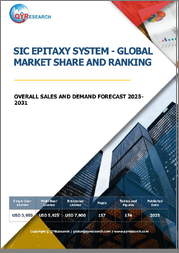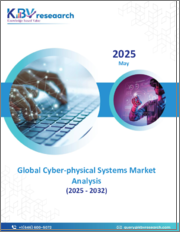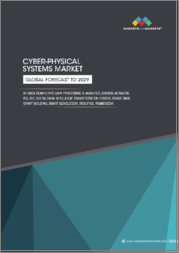
|
시장보고서
상품코드
1638083
세계의 사이버 물리 시스템 시장 규모, 동향, 산업 분석 보고서 : 구성요소별, 용도별, 업계별, 지역별 - 시장 예측(2022-2032년)Global Cyber-Physical Systems Market Size, Trends, and Industry Analysis Report, By Component, Application (Smart Grids, Digital Twins, Manufacturing), Vertical, and Region - Market Forecast (2022-2032) |
||||||
사이버 물리 시스템(CPS) 세계 시장 규모는 2023년에 1,074억 5,000만 달러로 2032년에는 3,930억 5,000만 달러에 달할 것으로 예측되며, 예측 기간 동안 15.5%의 CAGR을 기록할 것으로 예상됩니다.
사이버 물리 시스템은 물리적 요소와 디지털 요소를 통합하고 가상 세계와 현실 세계 간의 실시간 상호 작용을 가능하게함으로써 제조, 에너지, 헬스케어, 도시 인프라 등 여러 수직적 분야에서 혁신을 촉진합니다.
스마트 그리드, 디지털 트윈, 사물인터넷(IIoT)과 같은 CPS 기술은 생산성, 지속가능성, 보안을 향상시켜 산업 환경을 재편하고 있습니다. 산업계가 디지털 전환을 수용하면서 인공지능(AI), 로봇공학, 데이터 분석의 발전으로 CPS 도입이 가속화되고 있습니다. 이러한 시스템은 자원 활용을 최적화하고, 의사결정을 강화하며, 프로세스 자동화에 기여함으로써 디지털화된 생태계에서 경쟁력을 확보할 수 있도록 돕습니다.
주요 시장 촉진요인과 성장 기회
CPS에 대한 수요 급증은 주로 IoT 기기의 보급과 실시간 모니터링 및 예지보전을 가능하게 하는 스마트 기술의 발전으로 인한 것입니다. 혁신적인 CPS 기술인 디지털 트윈(Digital Twin)은 물리적 자산의 가상 복제본을 제공하고, 데이터 기반 인사이트를 통해 의사결정을 강화함으로써 운영 효율성을 높이고 있습니다.
에너지 분야, 특히 스마트 그리드는 효율적인 에너지 관리 시스템의 필요성으로 인해 CPS 시장에서 가장 큰 점유율을 차지하고 있습니다. 이러한 전력망은 에너지 배분을 최적화하고 재생에너지원을 통합함으로써 세계 지속가능성 목표에 부합합니다. 한편, 제조업은 CPS를 활용하여 생산 공정을 간소화하고, 자원 효율성을 보장하며, 자동화 및 적응형 제조 시스템의 혁신을 촉진하고 있습니다.
지역 분석 및 경쟁 상황
아시아태평양은 급속한 산업화, 스마트 인프라를 촉진하는 정부 이니셔티브, 제조 및 에너지와 같은 주요 부문의 첨단 기술 채택 증가에 힘입어 CPS 시장에서 가장 높은 성장률을 보일 것으로 예상됩니다. 중국, 일본, 인도와 같은 국가들은 IIoT 및 디지털 트윈 기술에 대한 막대한 투자를 통해 CPS 지원 솔루션 채택을 주도하고 있습니다.
북미와 유럽은 강력한 산업 인프라와 기술 혁신이 CPS 채택을 촉진하는 강력한 시장으로 남아 있습니다. 이들 지역의 정부는 스마트 시티 프로젝트와 같은 디지털 혁신 이니셔티브에 적극적으로 투자하고 있으며, 이는 CPS 시장을 더욱 확대시키고 있습니다.
시장 경쟁은 치열하며, 기존 기업들은 기술적 전문성과 전략적 파트너십을 통해 우위를 점하고 있습니다. 주요 전략으로는 제품 포트폴리오 확대, 지역 다각화, CPS 기능 강화를 위한 AI 활용 등이 있습니다.
사이버 물리 시스템 시장의 주요 업체
- ABB (Switzerland)
- Honeywell International Inc. (US)
- Rockwell Automation (US)
- Schneider Electric (France)
- Siemens (Germany)
- Continental AG (Germany)
- General Electric Company (US)
- Hitachi, Ltd. (Japan)
- Toshiba Corporation (Japan)
- Robert Bosch GmbH (Germany)
시장 세분화
목차
제1장 세계 사이버 물리 시스템(CPS) 시장 주요 요약
- 세계의 사이버 물리 시스템 시장 규모 및 예측(2022-2032년)
- 지역별 개요
- 부문별 개요
- 구성요소별
- 용도별
- 업계별
- 주요 동향
- 경기후퇴의 영향
- 애널리스트의 결론과 제안
제2장 세계의 사이버 물리 시스템 시장 : 정의와 조사 가정
- 조사 목적
- 시장 정의
- 조사 가정
- 포함과 제외
- 제한사항
- 공급측 분석
- 가용성
- 인프라
- 규제 프레임워크
- 시장 경쟁
- 경제적 실현 가능성(소비자의 관점)
- 수요측 분석
- 규제 프레임워크
- 기술적 진보
- 친환경
- 소비자 의식과 수용
- 조사 방법
- 조사 대상 연도
- 통화 환산율
제3장 세계의 사이버 물리 시스템 시장 역학
- 시장 성장 촉진요인
- IoT와 IIoT의 도입 증가
- 스마트 그리드와 에너지 효율에 대한 투자 증가
- 디지털 변혁을 지원하는 정부 이니셔티브
- 시장 과제
- 높은 도입 비용
- 플랫폼 간의 통합의 복잡성
- 시장 기회
- 스마트 시티 프로젝트 확대
- 첨단 제조 기술 성장
제4장 세계의 사이버 물리 시스템 시장 산업 분석
- Porter's Five Forces 모델
- 공급 기업의 교섭력
- 구매자의 교섭력
- 신규 참여업체의 위협
- 대체품의 위협
- 경쟁 기업 간의 경쟁 관계
- PESTEL 분석
- 정치적
- 경제적
- 사회적
- 기술적
- 법적
- 환경적
- 주요 투자 기회
- 주요 성공 전략
- 디스럽션 동향
- 업계 전문가의 관점
- 애널리스트의 결론과 제안
제5장 세계의 사이버 물리 시스템 시장 규모 및 예측 : 구성요소별(2022-2032년)
- 부문 대시보드
- 세계의 사이버 물리 시스템 시장 구성요소별 매출 동향 분석(2022 및 2032년)
- 소프트웨어
- 하드웨어
- 서비스
제6장 세계의 사이버 물리 시스템 시장 규모 및 예측 : 용도별(2022-2032년)
- 부문 대시보드
- 세계 사이버 물리 시스템 시장 용도별 매출 동향 분석(2022 및 2032년)
- 스마트 그리드
- 디지털 트윈
- 제조업
- 헬스케어
- 자동차
- 기타
제7장 세계의 사이버 물리 시스템 시장 규모 및 예측 : 업계별(2022-2032년)
- 부문 대시보드
- 세계의 사이버 물리 시스템 시장 업계별 매출 동향 분석(2022 및 2032년)
- 에너지
- 산업
- 자동차
- 헬스케어
- 항공우주 및 방위
- 기타
제8장 세계의 사이버 물리 시스템 시장 규모 및 예측 : 지역별, 2022-2032년
- 북미
- 미국
- 캐나다
- 유럽
- 독일
- 영국
- 프랑스
- 이탈리아
- 스페인
- 기타 유럽
- 아시아태평양
- 중국
- 일본
- 인도
- 한국
- 기타 아시아태평양
- 중동 및 아프리카
- 아랍에미리트
- 사우디아라비아
- 남아프리카공화국
- 기타 중동 및 아프리카
- 라틴아메리카
- 브라질
- 멕시코
- 기타 라틴아메리카
제9장 경쟁 정보
- 주요 기업 SWOT 분석
- ABB(Switzerland)
- Honeywell International Inc.(US)
- Siemens(Germany)
- 주요 시장 전략
- 기업 개요
- Rockwell Automation(US)
- Schneider Electric(France)
- Continental AG(Germany)
- General Electric Company(US)
- Hitachi, Ltd.(Japan)
- Toshiba Corporation(Japan)
- Robert Bosch GmbH(Germany)
제10장 조사 과정
- 조사 과정
- 데이터 마이닝
- 분석
- 시장 예측
- 검증
- 출판
- 조사 속성
The global Cyber-Physical Systems (CPS) Market was valued at USD 107.45 billion in 2023 and is projected to reach USD 393.05 billion by 2032, registering a CAGR of 15.5% during the forecast period. Cyber-physical systems integrate physical and digital elements, enabling real-time interactions between the virtual and real worlds, thereby fostering innovations across multiple verticals, including manufacturing, energy, healthcare, and urban infrastructure.
CPS technologies, such as smart grids, digital twins, and the Industrial Internet of Things (IIoT), are reshaping operational landscapes by improving productivity, sustainability, and security. As industries embrace digital transformation, CPS adoption has been accelerated by advancements in artificial intelligence (AI), robotics, and data analytics. These systems optimize resource utilization, enhance decision-making, and contribute to process automation, offering organizations a competitive edge in an increasingly digitized ecosystem.
Key Market Drivers and Growth Opportunities
The surge in demand for CPS is primarily fueled by the proliferation of IoT devices and the evolution of smart technologies that enable real-time monitoring and predictive maintenance. Digital twins, a transformative CPS technology, are driving operational efficiencies by providing virtual replicas of physical assets and enabling data-driven insights for enhanced decision-making.
The energy sector, particularly smart grids, holds the largest share in the CPS market, driven by the need for efficient energy management systems. These grids optimize energy distribution and integrate renewable energy sources, aligning with global sustainability goals. Meanwhile, the manufacturing vertical is leveraging CPS to streamline production processes, ensure resource efficiency, and foster innovation in automated and adaptive manufacturing systems.
Regional Analysis and Competitive Landscape
Asia Pacific is expected to exhibit the highest growth rate in the CPS market, supported by rapid industrialization, government initiatives promoting smart infrastructure, and increasing adoption of advanced technologies in key sectors like manufacturing and energy. Nations such as China, Japan, and India are leading the adoption of CPS-enabled solutions, driven by significant investments in IIoT and digital twin technologies.
North America and Europe also remain prominent markets, with strong industrial infrastructure and technological innovation propelling CPS adoption. Governments in these regions are actively investing in digital transformation initiatives, including smart city projects, which further expand the CPS market.
The market is characterized by robust competition, with established players leveraging their technological expertise and strategic partnerships to maintain dominance. Key strategies include expanding product portfolios, geographic diversification, and leveraging AI to enhance CPS capabilities.
Major Players in the Cyber-Physical Systems Market
1. ABB (Switzerland)
2. Honeywell International Inc. (US)
3. Rockwell Automation (US)
4. Schneider Electric (France)
5. Siemens (Germany)
6. Continental AG (Germany)
7. General Electric Company (US)
8. Hitachi, Ltd. (Japan)
9. Toshiba Corporation (Japan)
10. Robert Bosch GmbH (Germany)
Market Segmentation
By Component
- Software
- Hardware
- Services
By Application
- Smart Grids
- Digital Twins
- Manufacturing
- Healthcare
- Automotive
- Others
By Vertical
- Energy
- Industrial
- Automotive
- Healthcare
- Aerospace & Defense
- Others
By Region
- North America (US, Canada)
- Europe (UK, Germany, France, Italy, Spain, Rest of Europe)
- Asia Pacific (China, Japan, India, South Korea, Rest of Asia Pacific)
- Middle East & Africa (UAE, Saudi Arabia, South Africa, Rest of MEA)
- Latin America (Brazil, Mexico, Argentina, Rest of Latin America)
- Years Considered for the Study
- Historical Data: 2022- 2023
- Base Year: 2024
- Forecast Period: 2024-2032
Key Takeaways:
- Market projections and growth rates from 2022 to 2032.
- Segment-wise analysis with regional insights.
- Detailed competitive landscape, including strategic initiatives and technological advancements.
- Analysis of emerging opportunities in key verticals, including manufacturing, energy, and urban infrastructure.
Table of Contents
Chapter 1. Global Cyber-Physical Systems (CPS) Market Executive Summary
- 1.1. Global Cyber-Physical Systems Market Size & Forecast (2022-2032)
- 1.2. Regional Summary
- 1.3. Segmental Summary
- 1.3.1. By Component
- 1.3.2. By Application
- 1.3.3. By Vertical
- 1.4. Key Trends
- 1.5. Recession Impact
- 1.6. Analyst Recommendations & Conclusion
Chapter 2. Global Cyber-Physical Systems Market Definition and Research Assumptions
- 2.1. Research Objective
- 2.2. Market Definition
- 2.3. Research Assumptions
- 2.3.1. Inclusion & Exclusion
- 2.3.2. Limitations
- 2.3.3. Supply-Side Analysis
- 2.3.3.1. Availability
- 2.3.3.2. Infrastructure
- 2.3.3.3. Regulatory Environment
- 2.3.3.4. Market Competition
- 2.3.3.5. Economic Viability (Consumer Perspective)
- 2.3.4. Demand-Side Analysis
- 2.3.4.1. Regulatory Frameworks
- 2.3.4.2. Technological Advancements
- 2.3.4.3. Environmental Considerations
- 2.3.4.4. Consumer Awareness & Acceptance
- 2.4. Estimation Methodology
- 2.5. Years Considered for the Study
- 2.6. Currency Conversion Rates
Chapter 3. Global Cyber-Physical Systems Market Dynamics
- 3.1. Market Drivers
- 3.1.1. Rising Adoption of IoT and IIoT
- 3.1.2. Increasing Investments in Smart Grids and Energy Efficiency
- 3.1.3. Government Initiatives Supporting Digital Transformation
- 3.2. Market Challenges
- 3.2.1. High Costs of Implementation
- 3.2.2. Complexity in Integration Across Platforms
- 3.3. Market Opportunities
- 3.3.1. Expansion of Smart City Projects
- 3.3.2. Growth in Advanced Manufacturing Technologies
Chapter 4. Global Cyber-Physical Systems Market Industry Analysis
- 4.1. Porter's 5 Force Model
- 4.1.1. Bargaining Power of Suppliers
- 4.1.2. Bargaining Power of Buyers
- 4.1.3. Threat of New Entrants
- 4.1.4. Threat of Substitutes
- 4.1.5. Competitive Rivalry
- 4.2. PESTEL Analysis
- 4.2.1. Political
- 4.2.2. Economical
- 4.2.3. Social
- 4.2.4. Technological
- 4.2.5. Environmental
- 4.2.6. Legal
- 4.3. Top Investment Opportunities
- 4.4. Top Winning Strategies
- 4.5. Disruptive Trends
- 4.6. Industry Expert Perspective
- 4.7. Analyst Recommendations & Conclusion
Chapter 5. Global Cyber-Physical Systems Market Size & Forecasts by Component (2022-2032)
- 5.1. Segment Dashboard
- 5.2. Global Cyber-Physical Systems Market by Component Revenue Trend Analysis (2022 & 2032)
- 5.2.1. Software
- 5.2.2. Hardware
- 5.2.3. Services
Chapter 6. Global Cyber-Physical Systems Market Size & Forecasts by Application (2022-2032)
- 6.1. Segment Dashboard
- 6.2. Global Cyber-Physical SystemsMarket by Application Revenue Trend Analysis (2022 & 2032)
- 6.2.1. Smart Grids
- 6.2.2. Digital Twins
- 6.2.3. Manufacturing
- 6.2.4. Healthcare
- 6.2.5. Automotive
- 6.2.6. Others
Chapter 7. Global Cyber-Physical Systems Market Size & Forecasts by Vertical (2022-2032)
- 7.1. Segment Dashboard
- 7.2. Global Cyber-Physical Systems Market by Vertical Revenue Trend Analysis (2022 & 2032)
- 7.2.1. Energy
- 7.2.2. Industrial
- 7.2.3. Automotive
- 7.2.4. Healthcare
- 7.2.5. Aerospace & Defense
- 7.2.6. Others
Chapter 8. Global Cyber-Physical Systems Market Size & Forecasts by Region (2022-2032)
- 8.1. North America Cyber-Physical Systems Market
- 8.1.1. U.S. Cyber-Physical Systems Market
- 8.1.1.1. By Component
- 8.1.1.2. By Application
- 8.1.1.3. By Vertical
- 8.1.2. Canada Cyber-Physical Systems Market
- 8.1.1. U.S. Cyber-Physical Systems Market
- 8.2. Europe Cyber-Physical Systems Market
- 8.2.1. Germany Cyber-Physical Systems Market
- 8.2.2. UK Cyber-Physical Systems Market
- 8.2.3. France Cyber-Physical Systems Market
- 8.2.4. Italy Cyber-Physical Systems Market
- 8.2.5. Spain Cyber-Physical Systems Market
- 8.2.6. Rest of Europe Cyber-Physical Systems Market
- 8.3. Asia Pacific Cyber-Physical Systems Market
- 8.3.1. China Cyber-Physical Systems Market
- 8.3.2. Japan Cyber-Physical Systems Market
- 8.3.3. India Cyber-Physical Systems Market
- 8.3.4. South Korea Cyber-Physical Systems Market
- 8.3.5. Rest of Asia Pacific Cyber-Physical Systems Market
- 8.4. Middle East & Africa Cyber-Physical Systems Market
- 8.4.1. UAE Cyber-Physical Systems Market
- 8.4.2. Saudi Arabia Cyber-Physical Systems Market
- 8.4.3. South Africa Cyber-Physical Systems Market
- 8.4.4. Rest of Middle East & Africa Cyber-Physical Systems Market
- 8.5. Latin America Cyber-Physical Systems Market
- 8.5.1. Brazil Cyber-Physical Systems Market
- 8.5.2. Mexico Cyber-Physical Systems Market
- 8.5.3. Rest of Latin America Cyber-Physical Systems Market
Chapter 9. Competitive Intelligence
- 9.1. Key Company SWOT Analysis
- 9.1.1. ABB (Switzerland)
- 9.1.2. Honeywell International Inc. (US)
- 9.1.3. Siemens (Germany)
- 9.2. Top Market Strategies
- 9.3. Company Profiles
- 9.3.1. Rockwell Automation (US)
- 9.3.2. Schneider Electric (France)
- 9.3.3. Continental AG (Germany)
- 9.3.4. General Electric Company (US)
- 9.3.5. Hitachi, Ltd. (Japan)
- 9.3.6. Toshiba Corporation (Japan)
- 9.3.7. Robert Bosch GmbH (Germany)
Chapter 10. Research Process
- 10.1. Research Process
- 10.1.1. Data Mining
- 10.1.2. Analysis
- 10.1.3. Market Estimation
- 10.1.4. Validation
- 10.1.5. Publishing
- 10.2. Research Attributes



















